12
Records, Artefacts and Memorabilia
Like most records those of OCS are patchy. This stems from two main factors: one the decision to destroy unit records on a value judgement made by persons who usually have little idea of what might be valuable to both researchers and curators, relying on what they themselves may consider to be useful; the other results from the enthusiasm or otherwise of cadets and staff at different periods and in different emphases on a variety of topics. A considerable volume of unit files was transferred to the Australian Archives for custody, forming a valuable resource on the School’s official background; an equally large portion was not and has apparently ceased to exist. In addition Army Headquarters-Army Office and Training Command files are very sparse, again emphasising the present national problems on archival policy and practice, a topic which is currently the subject of both heated and constructive discussion amongst historians and archivists (1), with unfortunate losses of material ongoing in the interim.
On closure of the School some effort was made to assemble memorabilia and pass it to RMC where the Archives has the full range of course scrapbooks, some of which demonstrate a very casual interest in preserving individual class memories, others with a welcome completeness as indicated by the weighting of photographs in this book. The class photograph collection is fairly complete, some gaps indicating unprincipled piracy over the years, which is also observable in the gaps in the scrapbooks where some of the apparently more interesting photographs exist in caption only. The remainder of documentary material is sparse, limited to the graduation rolls and some sporting team photographs. However those items of regimental property, principally trophies, honour boards and flags which were on charge to the quartermaster, which unfortunately did not include internal artefacts, were photographed and transferred intact to Canberra.
Progressive build up of a range of awards for military and sporting achievements meant that there was an accompanying collection of honour boards and perpetual trophies. These varied from the major ones shown in Chapters 7 and 10 to endless inter-company, inter-platoon and individual event cups and shields. Their absorption into use was obviously a problem in a well-established college already overendowed with its own: a store room at Duntroon contains scores of unused trophies from RMC’s own past, accumulated and passed over as times, military activities and sports changed. To this was added scores more from Portsea, which included those which OCS inherited from OTU and WRAAC OCS. Some of the major ones will be suitable for display, but most are destined to remain with the superseded RMC ones, stored and available for future use if the need should arise.
Honour Boards
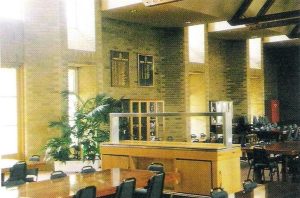
These boards and those for the Governor General’s Medal are displayed in the Cadet’s Mess along with those of RMC and the awards from Scheyville.
Just as the traditions of OTU Scheyville and WRAAC OCS Georges Heights were progressively absorbed into OCS Portsea, so all these migrated to Duntroon in 1986.
RMC Archives
The fate of Portsea’s artefacts has been of both interest and concern. It is apparent that there was an underlying misapprehension amongst many graduates that there had been an act of damnatio – the ultimate Roman sanction of erasure of all record of the past – in this case OCS’s past at the Royal Military College. Nothing could be further from fact. The OCS honour boards are prominently displayed in the Corps of Staff Cadets Mess where the mess silver inscribed with its origin is in regular use; the main trophies are stored for future display or use, the Roll of Honour has been recreated on the terrace above the parade ground beside the tablets for RMC graduates, and the Colours are displayed in the RMC Chapel.
OCS Major Trophies
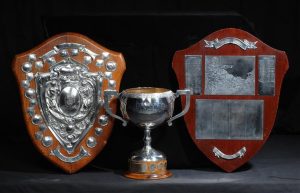
The Rowell Shield, Harrison Cup and Kiel Shield were the core of internal military and sporting competition at Portsea.
At present they are in storage at the temporary museum, awaiting display when the permanent museum opens in 1996.
RMC Archives
The Commandant of RMC is in the process of establishing a museum, which the Duntroon Society has undertaken to support financially: a room in this museum will be provided for OCS artefacts and memorabilia. In addition the new administrative building to be completed in 1996 will be named as the Badcoe Building after the OCS Victoria Cross winner, replacing Badcoe Hall at Portsea. In addition it is proposed to name rooms in the building after notable graduates of all streams of the previous officer production system, and OCS graduates will feature in this.
Colours
When OCS had settled down to a more routine form of running and it was apparent that it was to be a permanent component of the army, commandants and staff had the leisure and incentive to acquire for the Company of Officer Cadets its fair share of the trappings appropriate to its status. An application was made to Army Headquarters in June 1960 for Queens and Regimental Colours for the Company of Officer Cadets. The application was favourably received and, gaining endorsement of the Military Board, the appropriate designs were prepared by the Master General of the Ordnance’s Branch and forwarded for royal approval. However such applications were then processed through the British War Office, where it was rejected on the basis that their Mons Officer Cadet School were equivalent to Portsea (which was not so, its function and course content was equivalent to that of Sandhurst), and as Mons had no colours, the application for Portsea must be rejected. It was a sad commentary on the lack of independence of the Australian Army, and also by implication national independence, that such an application for approval by the Head of State should be subject to ambush by the British army as if it was a superior headquarters, but such was the effective result.
Colours of the Company of Officer Cadets
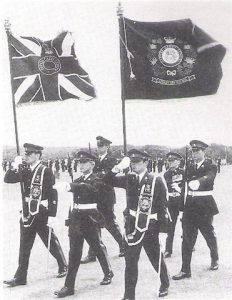
Granted unnecessarily-late in OCS’s progress, they were designed to the standard of the time of presentation: Union Flag Queen’s colours were progressively replaced throughout the Australian Army with an Australian Flag from the mid-1970s, the foreseeable end to OCS militated against such a change, and the relic of another era regretfully remained unchanged.
Originally designed as a unit’s leading and rallying focus on a closequarters combat battlefield, they served as a focus for the regular ceremonial activity at Portsea.
Their presentation in mid-1968 officially acknowledged that OCS had emerged from the initial equation with Mons-Eton Hall and was ranked amongst the leading officer training academies of the Commonwealth of Nations.
OCS Scrapbook 1972
The next attempt was initiated in 1967 when a changing climate in an Australian Army fighting for the first time outside the Imperial-Commonwealth umbrella provided more determined approach which resulted in British Ministry endorsement. The design of the colours was given royal approval, the Commonwealth Government Clothing Factory delivered the colours and they were presented by Prince Phillip as a Field Marshal of the Australian Army on 1 June 1982. Their design was the thenstandard Queens Colour of a Union Flag with the OCS motif in the centre, and the Regimental Colour an infantry green flag with the regimental badge, title and motto surrounded by wattle sprigs.
The presentation parade was held at the South Melbourne Cricket Ground. While the Portsea parade ground was both the most appropriate and picturesque, it was simply too cramped to handle a ceremony and spectacle of this magnitude, and as well enable the public to attend such a significant royal appearance; while allowing the cadets to bask in well earned public acclaim. Fortunately at this stage it was possible to have an ecumenical blessing of the colours, in stark contrast to the religious problems of the 1954 presentations at the Royal Military College and the Royal Australian Naval College, in this case the Anglican chaplain consecrating, the Roman Catholic blessing and the Other Protestant Denominations dedicating. It was also a fortunate time of year, just before graduation, so that the junior class had had five months to perfect themselves, and the Company of Officer Cadets was able to put on the cameo performance which the occasion demanded (3).
Presentation of Queen’s and Regimental Colours to the Company of Officer Cadets
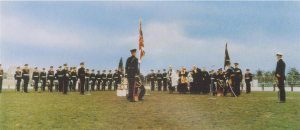
Presentation of Queen’s and Regimental Colours to the Company of Officer Cadets by
Field Marshal Prince Phillip Duke of Edinburgh
South Melbourne Cricket Ground 1 June 1968
Photo: RMC Archives
The Colours were the centre piece of subsequent ceremonial parades and guards of honour, and after their final outing at the last graduation at Portsea, there remained one further official duty to them. The Army has long had a standard procedure for disposal of replaced colours or those of past units. The British practice was to lay them up in a church, suspended from the ceiling, where they remained until they disintegrated. This was perhaps a reasonable approach in an army which had seen such a wide variety and number of units over the centuries, and it was natural that the Australian Colonial and Commonwealth forces should follow suit. However in an age conscious of its limited tradition, and one in which preservation techniques can stay the ravages of time, colours are now preserved in a controlled environment.
Officer Cadet School Queen’s and Regimental Colours

This was the more fortunate end for the OCS Colours. Farewelled on a ceremonial parade at RMC by the Corps of Staff Cadets on 23 March 1986, they were laid up in the RMC Chapel alongside RMC’s old colours. It was very fitting that the cadets on parade were led by those of the ungraduated class from OCS now completing their training at Duntroon: the spirit lived on.
The Colours in the RMC Chapel
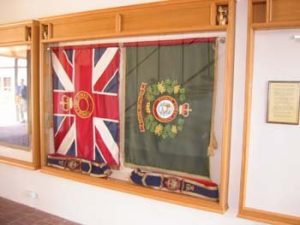
Officer Cadet School Colours Farewell
Marching off the OCS Colours
Duntroon 23 March 1986
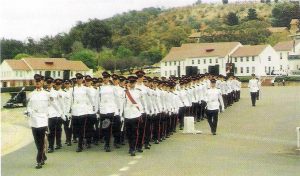
The Corps of Staff Cadets of the Royal Military College of Australia, whose senior class comprised the last class of Portsea completing their course there, provided a fitting escort to the Colours en route to their resting place in the RMC Anzac Chapel, where they remain on display.
RMC Archives
OCS Colours for laying up
Duntroon 23 March 1985
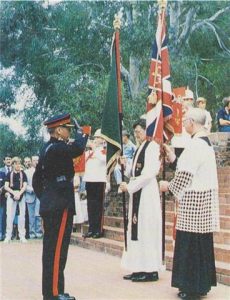
Ex-commandant of OCS Brig P. Davies passing the Colours to the College Chaplains for custody in the RMC Anzac Chapel.
RMC Archives
OCS Colours laid up RMC Chapel
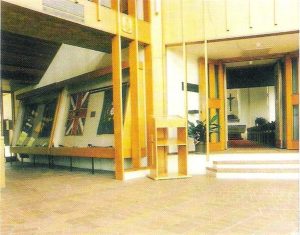
The colours of the Corps of the Company of Officer Cadets were paraded for the last time on 23 March 1986 by the Corps of Staff Cadets, which included as its first class the last intake to Portsea which moved to Duntroon at the end of 1985.
The colours were then escorted to the Anzac Chapel where they are laid up beside the old RMC colours which had been replaced by ones with the Australian flag. The OCS colours remained the style of another era, there being no impetus to change to adopting more national symbols in the last few years of the School.
RMC Archives
Badges and Insignia
Initially the gilt rising sun badge was used with headgear – the collar badge with khaki and blues caps, and the hat badge with the slouch hat, but as the School became established, inaugural commandant Colonel J.W. Harrison set the design of a badge in train. It had to be representative of the function of the institution which was to provide officers to the Australian Staff Corps, so he selected the general staff motif from the badge of that corps, placed in a garter containing the name of the School, with a scroll beneath carrying the motto and a crown surmounting the badge. The motto caused the greatest problem: a Latin one was sensibly avoided as were trite or hackneyed ones. Eventually after considerable consultation with his staff Harrison chose Loyalty and Service as epitomising the values which he hoped to instill in his charges.
This badge design was submitted to Army Headquarters where there was heraldic opposition to the surmounting crown, as there were two already built into the general staff insignia, and although Harrison declaimed that without it the design looked like ‘an egg on a lettuce leaf’ it was officially approved in December 1955, minus the extra crown, proving to be a handsome well balanced badge despite the misgivings of its instigator. A further approval was obtained in September 1960, after considerable to-ing and fro-ing between the School and Army Headquarters, for colour embellishments for use on signs and flags comprising buttercup for the edges, saffron for the lion, garter blue for the background of the lion and cherry for the garter and scroll. A further colour modification for the badge was its being worn with red backing on the summer ceremonial jacket. But for all the delay the badge had been in quasi-official use for nearly two years on trophies, unit signs, programmes, stationary and the Journal.
OCS Badges
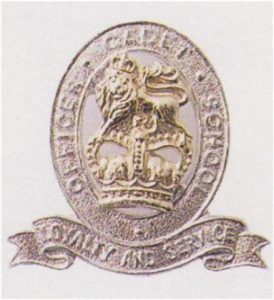
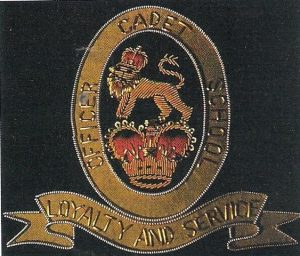
For various reasons OCS did not use the full array of corps and formation signs available or mandatory in the army at various times. This is understandable in the short courses where both the ‘normal course’ mentality and the shortness of the period militated against the sewing on and replacing of formation signs. Further, the establishment of the Company of Officer Cadets as a Corps in 1969 came ten years after woven shoulder titles were disenfranchised. Corps buttons and metal OCS shoulder titles made their appearance progressively. A carryover from the pre-badge days was the white gorget patch used initially on battledress and blues, remaining for the former after the introduction of collar badges in 1956. The left collar badge also became the cap and hat badge.
Officer Cadet School Flag
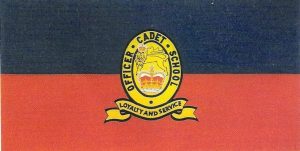
Some service-entrant cadets brought skill badges with them including the crossed-rifle marksman badges with letters signifying the weapon qualified, which could also be earned at Portsea, the parachutist badge and Special Air Service badge. In addition, those who were awarded and retained cadet rank wore the normal insignia appropriate to the equivalent rank as shown in Chapter 8, except that the colour sergeant appointment had crossed flags intersplaced between the chevrons and crown of the parallel staff sergeant rank; the Austrian knot used for under officers at RMC was not adopted at OCS. Two other badges were in use for non-uniform uniforms. Blazers or reefer jackets had at first an embroidered version of the full-colour OCS badge for the pocket, subsequently replaced by a bullion version. The other was a washable version of the badge for the tracksuit jacket.
Uniforms
With its hasty inauguration, the uniforms of the School were limited to what was available within the normal military supply system with minor embellishment, and in 1952 the Army’s inventory of clothing was extremely limited in both scope and quality. The service dress of two world wars had just been replaced by a battledress, and a blue open collar ceremonial-walking out uniform resurrected, though not in the corps variants of the pre-World War 2 years. Summer uniform was simply starched khaki drill shirt and trousers: it was some years after the Department of Supply had provided a handsome khaki polyester uniform as working dress for its labourers that Army was able to introduce a similar one for general duty and ceremonial for its soldiers. The same khaki drill was used as field dress, which is what it was designed for. There were no officer pattern uniforms on issue other than the blues which were barathea rather than the standard twill, officers being expected to purchase tailored summer and winter service dress at their own expense from a uniform allowance which bore no resemblance to the cost of such uniforms.
It was therefore unavoidable that the early officer cadets would be clothed in standard Q Store uniforms: khaki drill, battle dress, and other rank blues. The two small concessions were to recognise the status of the cadets: white gorget patches for use with battle dress and blues, and officer pattern khaki barathea caps for other than field or working dresses. There was a real limit for a 22 week course, as it took as long to have uniforms made to order from the Commonwealth Government Clothing Factory, so issues of officer pattern blues were not a practical proposition until the course was extended to a year, when they could replace the interim issue blues about mid-course when they had been made to measure; but it is an unfortunate fact that the standard of fitting of the output of the Factory was so poor that even a modest range of standard sizes would have produced a far better result. This was not to be a problem, as for economy sake no issue of officer pattern uniforms was authorised, leading to a consequential problem: at the end of the 1960s, when other rank blues were replaced by khaki service dress, there was no general army requirement for them and, as they wasted out, the ludicrous situation arose where it became necessary to buy them specially for the officer cadets. Sanity won out in 1977.
As the basic uniforms of the Army were developed to improved patterns and material quality, these became standard issue for the cadets. So the polyester summer shirt and trousers replaced the drill, jungle greens replaced the khaki protective dress, a heavy duty green pullover replaced the khaki jumper, and a white jacket was provided for summer ceremonial use as had been done earlier at RMC. White mess jackets for formal evening wear in place of the blues jacket had been available as pool issues from 1961, and became a personal issue in 1974.
General Duty Uniforms
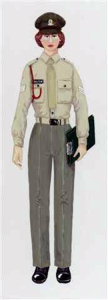 Sergeant, Summer Lecture Order, mid-1960s-80s
Sergeant, Summer Lecture Order, mid-1960s-80s
Polyester-wool uniforms became standard general duty dress for the army in the mid1960s, several years after it had been adopted as a working dress for Department of Supply labourers, a welcome if much overdue change from starched khaki or green drill. It could be worn with short sleeved shirts with open collar or long sleeved with knitted woollen ties which always seemed too short. The lightweight sweater was added for cool weather, however on introduction of the heavy howard green ‘w
oolly pully’ this was phased out, leaving too-hot or too-cold options in mild climates. Officer pattern caps with OCS badge were usual headdress, with a khaki or red lanyard, according to class.
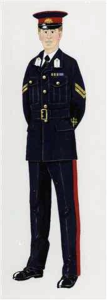
Corporal, Mess and Walking Out Dress, 1950s-mid 1970s
Other rank blues and cap were used as mess and ceremonial dress from OCS’s inception. The white gorget patches, and from 1956 their replacement the OCS left and right collar badges, provided the only identification as officer cadets. Ceremonial wear required the addition of a sam browne belt with infantry sword or whitened 1937 pattern web belt, bayonet frog and scabbard and rifle as appropriate. Badges of rank, specialist and skill badges and medals or ribbons were worn as appropriate.
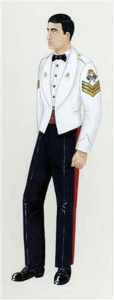 Colour Sergeant, Summer Mess Dress, early 1960s-80s
Colour Sergeant, Summer Mess Dress, early 1960s-80s
The white mess jacket, an optional summer mess dress as a self-purchase choice for officers, was made available at OCS with a pool of used jackets on loan issue, recycled in succeeding years. It finally became a normal issue for cadets in 1974. It was worn with the usual blues trousers, with OCS collar badges on the lapels, white shirt, red cummerbund and black bow tie, with gold and embroidered badges of rank and specialist badges as appropriate.
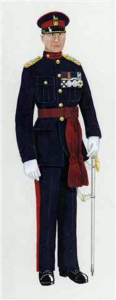 Commandant, Winter Ceremonial Dress, 1950s-80s
Commandant, Winter Ceremonial Dress, 1950s-80s
Decorative belts for senior officers were introduced as full ceremonial order of dress in the Australian Army in 1951, but were not in common use, as plainness of dress had prevailed since early Federation, particularly after one minister had described some officers at an official function as looking ‘like refugees from an hareem’. It was more adapted for use overseas to match the full dress affected by more narcissistic nations, however the ceremonial activities, of military college parades, with full dress visitors, provided some incentive and justification to adopt this more flamboyant rig.
Art: Lindsay Cox
Field Uniforms
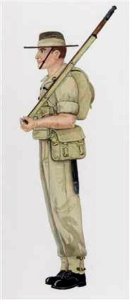 Officer Cadet, Marching Order, 1950s-early 1960s
Officer Cadet, Marching Order, 1950s-early 1960s
The basic training uniform at OCS was protective dress, a free issue khaki drill combination which comprised pre-owned clothing from stock, embracing a wide variety of shirts, jackets and trousers. The slouch hat, with rising sun or OCS badge, had an alternative strapped on the back of the pack in the steel helmet of the two world wars. Equipment comprised 1937 pattern basic webbing, pack and haversack, with SMLE rifle and 1907 pattern bayonet. The inefficient 1937 pattern web anklets remained until introduction of the Australian pattern gaiter, then in 1973 by general purpose calf-length boots, nearly a decade after their first introduction into the army.
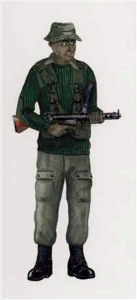
Officer Cadet, Winter Weapon Training Order, late 1970s-80s
Green drill protective dress was reintroduced into the army in the late 1950s for field force units, spreading to the army at large in the early 1960s. The original light khaki pullover was replaced by a heavyweight howard green one in the 1970s; the initial pattern of green trouser had also been replaced by the one depicted, as had ankle boots by general purpose boots. The US pattern web equipment replaced the 1937 pattern in the early 1960s, and the F1 submachine carbine the Owen gun.
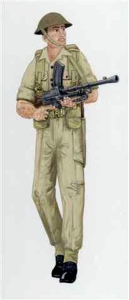
Officer Cadet, Battle Order, 1950s-early 1960s
Field dress was the same for summer and winter. Battledress was never afield order, being considered too good and used as both general duty and walking out dress in an army otherwise without a uniform between working dress and blue formal dress. The protective dress depicted was augmented with a lightweight pullover and greatcoat for cold weather use, a range of protection with a wide gap in the middle. Webbing remained the 1937 pattern, with the anklets retained, even though Australian pattern gaiters had been developed at the end of World War 2 and could be purchased in disposals stores.
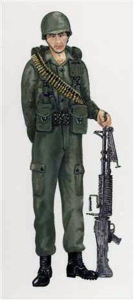
Officer Cadet, Battle Order 1960s-80s
Until the early 1960s the Australian soldier’s basic outfitting differed little in dress, equipment and weapons from that of his predecessor in the Western Desert in World War II. Reequipment took the quick and easy approach of buying American, a sensible measure to meet a neglected and overdue need. While the uniform was Australian and did not meet the lightweight, rip-stop and other beneficial characteristics of US developments, the web equipment, helmet and depicted M60 machine gun were direct and useful solutions to an urgent requirement. The general purpose boots were locally designed calf length leather with composite sole.
Art: Lindsay Cox
Ceremonial Uniforms
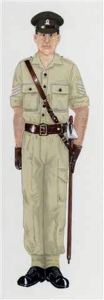
Sergeant, Summer Drill Order Ceremonial, 1950s-60s
The basic army summer uniform of the 1950s was khaki drill shirt and trousers, a reversion from the later World War II green drill of the tropics, to reflect the Australian Army’s perceived role as being once again in the Middle East. In days before the army caught the Vietnam-era American prejudice of regarding rolled long sleeves as yobbo standard, neatly folded sleeves were well accepted as utilitarian and well dressed. Boots were of the long-standing ankle length, now dyed black from the traditional tan, and worn with 1937 pattern web anklets. For ceremonial parades and sword drill the sam browne belt with infantry sword was used, and the single concession to the officer cadet’s status as an officer candidate was the officer pattern cap, initially with the gilt Australian Military Forces rising sun hat badge, then from 1956 the OCS silver and gilt badge.
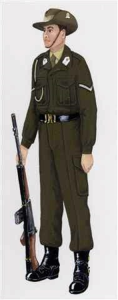
Officer Cadet, Winter Drill Order, 1950s-80s
The basic army winter uniform was the battledress, an Australian version of the British one of over ten years earlier, and replacing the Service Dress which had seen service in both World Wars. It was worn with collar and tie, and either slouch hat or officer pattern cap with rising sun and later OCS badge. Web equipment was initially blancoed, then boot polish blackened 1937 belt and Australian pattern gaiters. White gorget patches indicated officer cadet status, as badges were not worn on battledress lapels; a khaki lanyard depicted junior class, red the seniors. The rifle changed from the short magazine Lee-Enfield rifle to self loading rifle in 1960.
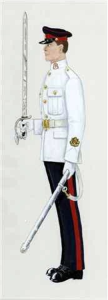
Senior Under Officer, Summer Ceremonial Dress, late 1970s-80s
White terylene jackets replaced the blue jacket for summer ceremonial wear in 1977. It was worn with the blue trousers, and either whitened 1937 pattern web belt and rifle or 1887 pattern white leather belt and furniture with stainless steel scabbard and infantry sword, the latter replacing the sam browne equipment for ceremonial parades. Badges of rank were standard warrant and non-commissioned officer gold and embroidered insignia, as were specialist skill badges.
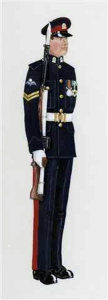 Corporal, Winter Ceremonial Dress, mid 1970s-80s
Corporal, Winter Ceremonial Dress, mid 1970s-80s
Patrol collar blues had become standard for commissioned and warrant officers in 1970, and although the other ranks blues were no longer an issue uniform, the latter continued in use at Portsea until 1977. They doubled as winter mess dress and ceremonial, the latter with the addition of whitened 1937 pattern web belt and officer pattern blues cap. Badges of rank and specialist insignia were normal gold/embroidered issue.
Art: Lindsay Cox
Accoutrements and field equipment also changed as did those of the Army in general. The 1937 pattern webbing was replaced by the US pattern, the slouch hat for field use by the floppy green hat. Some 1937 pattern webbing remained for extended use: the belt remained as a drill belt, first blancoed then blackened with boot polish; the anklets remained as part of drill-ceremonial order after the Australian pattern gaiter was introduced for field wear in 1959, and those mud gaiters were then blackened for drill-ceremonial wear to match the belts; a separate belt was also whitened for ceremonial use with blues and the white summer jacket.
References
- York B. ‘Nightmare on Archive Street: sentencing – why, how and by whom?’ Australian Historical Association Bulletin September 1993; Tuckey S. ‘Not quite a pleasant dream, but not a nightmare’ AHA Bulletin December 1993 and subsequent articles by Nelson H. and York B. in AHA Bulletin August 1994.
- OCS Journal December 1985, p41.
- AA B2453/1R274/1/1 of 20 May 1968.
- OCS Journal December 1972, p7f, with some amendment.